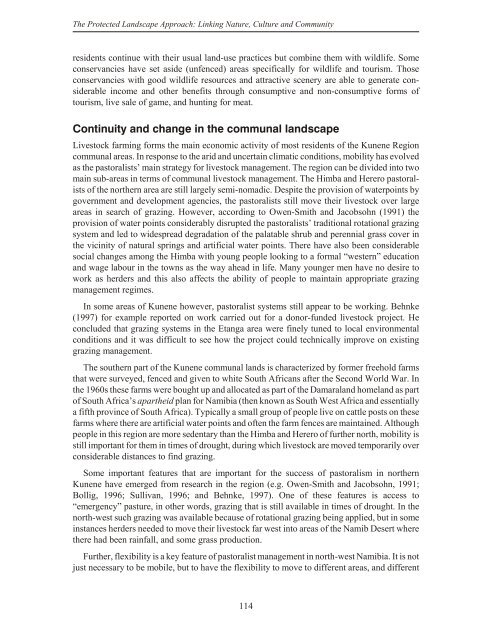The Protected Landscape Approach - Centre for Mediterranean ...
The Protected Landscape Approach - Centre for Mediterranean ...
The Protected Landscape Approach - Centre for Mediterranean ...
You also want an ePaper? Increase the reach of your titles
YUMPU automatically turns print PDFs into web optimized ePapers that Google loves.
<strong>The</strong> <strong>Protected</strong> <strong>Landscape</strong> <strong>Approach</strong>: Linking Nature, Culture and Community<br />
residents continue with their usual land-use practices but combine them with wildlife. Some<br />
conservancies have set aside (unfenced) areas specifically <strong>for</strong> wildlife and tourism. Those<br />
conservancies with good wildlife resources and attractive scenery are able to generate con -<br />
siderable income and other benefits through consumptive and non-consumptive <strong>for</strong>ms of<br />
tourism, live sale of game, and hunting <strong>for</strong> meat.<br />
Continuity and change in the communal landscape<br />
Livestock farming <strong>for</strong>ms the main economic activity of most residents of the Kunene Region<br />
communal areas. In response to the arid and uncertain climatic conditions, mobility has evolved<br />
as the pastoralists’ main strategy <strong>for</strong> livestock management. <strong>The</strong> region can be divided into two<br />
main sub-areas in terms of communal livestock management. <strong>The</strong> Himba and Herero pastoral -<br />
ists of the northern area are still largely semi-nomadic. Despite the provision of waterpoints by<br />
government and development agencies, the pastoralists still move their livestock over large<br />
areas in search of grazing. However, according to Owen-Smith and Jacobsohn (1991) the<br />
provision of water points considerably disrupted the pastoralists’ traditional rotational grazing<br />
system and led to widespread degradation of the palatable shrub and perennial grass cover in<br />
the vicinity of natural springs and artificial water points. <strong>The</strong>re have also been considerable<br />
social changes among the Himba with young people looking to a <strong>for</strong>mal “western” education<br />
and wage labour in the towns as the way ahead in life. Many younger men have no desire to<br />
work as herders and this also affects the ability of people to maintain appropriate grazing<br />
management regimes.<br />
In some areas of Kunene however, pastoralist systems still appear to be working. Behnke<br />
(1997) <strong>for</strong> example reported on work carried out <strong>for</strong> a donor-funded livestock project. He<br />
concluded that grazing systems in the Etanga area were finely tuned to local environmental<br />
conditions and it was difficult to see how the project could technically improve on existing<br />
grazing management.<br />
<strong>The</strong> southern part of the Kunene communal lands is characterized by <strong>for</strong>mer freehold farms<br />
that were surveyed, fenced and given to white South Africans after the Second World War. In<br />
the 1960s these farms were bought up and allocated as part of the Damaraland homeland as part<br />
of South Africa’s apartheid plan <strong>for</strong> Namibia (then known as South West Africa and essentially<br />
a fifth province of South Africa). Typically a small group of people live on cattle posts on these<br />
farms where there are artificial water points and often the farm fences are maintained. Although<br />
people in this region are more sedentary than the Himba and Herero of further north, mobility is<br />
still important <strong>for</strong> them in times of drought, during which livestock are moved temporarily over<br />
considerable distances to find grazing.<br />
Some important features that are important <strong>for</strong> the success of pastoralism in northern<br />
Kunene have emerged from research in the region (e.g. Owen-Smith and Jacobsohn, 1991;<br />
Bollig, 1996; Sullivan, 1996; and Behnke, 1997). One of these features is access to<br />
“emergency” pasture, in other words, grazing that is still available in times of drought. In the<br />
north-west such grazing was available because of rotational grazing being applied, but in some<br />
instances herders needed to move their livestock far west into areas of the Namib Desert where<br />
there had been rainfall, and some grass production.<br />
Further, flexibility is a key feature of pastoralist management in north-west Namibia. It is not<br />
just necessary to be mobile, but to have the flexibility to move to different areas, and different<br />
114

















